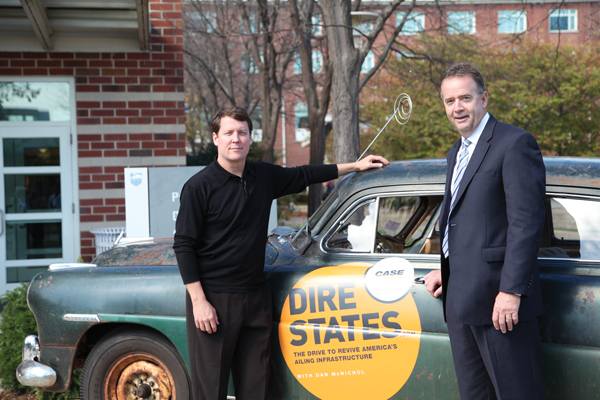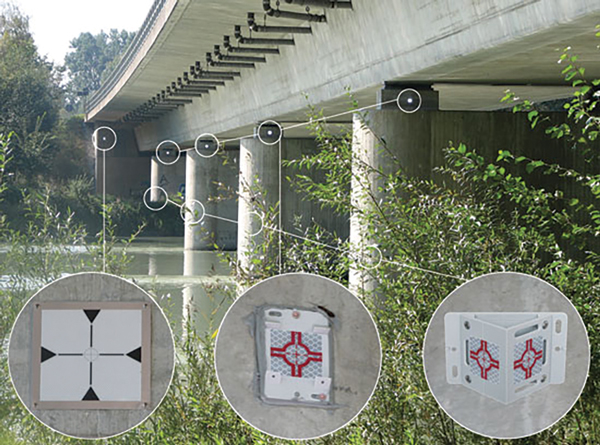
Infrastructure is a buzzword. It is a go-to talking point for pundits and politicians on every drive-time radio program and cable news network. Even with all this talk, according to the Congressional Budget Office, if current infrastructure funding through MAP-21 is not extended or new legislation is not enacted, the Highway Trust Fund will have "insufficient funds to meet obligations starting in fiscal year 2015." Federal funding for highway and transit projects will dry up beginning this summer. We keep talking, but the problem remains the same.
 The dire state of America's infrastructure extends well beyond roads and transit. Waterways, waste, energy, levees, dams and drinking water systems are all part of a failing network.
The dire state of America's infrastructure extends well beyond roads and transit. Waterways, waste, energy, levees, dams and drinking water systems are all part of a failing network.Enacting long-term federal funding is critical, as public safety, jobs and the nation's overall economic well-being are at stake. But a federal infusion of cash into the Highway Trust Fund only addresses the problem from one angle. The dire state of America's infrastructure extends well beyond roads and transit.
Waterways, waste, energy, levees, dams and drinking water systems are all part of a failing network. The American Society of Civil Engineers (ASCE) launched its Infrastructure Report Card in 2013. The report gives America's infrastructure, as a whole, a grade of D-plus.
However, the news is not all dire, and federal funding is not the only solution. Infrastructure author Dan McNichol discovered challenges and amazing accomplishments pertaining to the nation's infrastructure as part of his Dire States tour the country.
The tour encountered several people who are taking the initiative locally by working around the federal funding shortfall.
Pennsylvania Owns Up
Pennsylvania had a weight problem. People often think of infrastructure funding as addressing new construction, but maintenance and repair are also critical issues. As more bridges fell into the structurally deficient category, weight limits were enacted, requiring trucks to be rerouted across acceptable bridges. Rerouting commercial haulers raises significant expenses related not only to mileage, fuel and lost time, but also to added wear and tear on trucks.
Pennsylvania made an excellent case to the public, laying out the troubles facing the state's roads and bridges. More bridges would be weight-limited. Roads would deteriorate and leave commuters spending more time on the road and more money on fuel and repairs. Congestion would increase. Public safety would suffer.
The price of goods and services would go up. The state would lose jobs due to a lack of access to job-creating commerce centers.
Pennsylvania HB 1060 was signed into law in November 2013, and encompassed a number of different revenue-raising measures, including updates to some vehicle and fuel tax fees that had not been adjusted for inflation since the 1990s. According to the state's department of transportation, the legislation will "invest an additional $2.3 to $2.4 billion into transportation by the fifth year of the plan.
"Partial funding for the new transportation package is being derived from the elimination of the flat 12-cent gas tax and modernizing an outdated transportation financing structure through the uncapping of the wholesale, Oil Company Franchise Tax."
The bill will also create new jobs. According to PennDot: "A $2.3 billion dollar investment will generate a net of 62,000 jobs. 50,000 new jobs will be created, and 12,000 additional jobs will be preserved."
The Dam the Town Built
The town of Black River Falls, Wisconsin became a symbol for what the Dire States tour was all about—owning your infrastructure at a local level.
The town's dam had stood for nearly 100 years when studies determined it needed to be replaced. Faced with this reality, the town took out a loan for approximately $10 million to replace the dam and add a third hydroelectric generator. This was important to the community on many levels.
The dam is responsible for roughly 10 percent of the town's electricity. This clean and renewable source of energy allows the town to produce energy at one to two cents per kilowatt hour, whereas that same energy would cost 10 to 11 cents per kilowatt hour if it was purchased from a third party. Those cost savings are passed through to the community.
In addition to the practical utility benefits, the reservoir created by the dam allows for water recreation and tourism in the community, and spurs waterfront development that helps pump tax revenue and further growth into the town.
For the 3,500 residents of this small rural town in western Wisconsin, it was an important investment.
 Dan McNichol and Pennsylvania Secretary of Transportation Barrry Schoch
Dan McNichol and Pennsylvania Secretary of Transportation Barrry SchochFinding Water in the Desert
Buckeye, Arizona and the people of the Water Infrastructure Finance Authority of Arizona (WIFA) opened our eyes to the challenges of collecting fresh water in the desert and the innovative funding methods available to make infrastructure improvements a reality. The town of Buckeye has begun a number of water infrastructure improvement projects that include rehabbing old wells to reach deeper and provide additional sources of clean water, as well as wastewater reclamation projects.
Through its work with WIFA, Buckeye was able to secure three loans totaling more than $13.5 million in 2013, as well as an additional $1 million loan. This funding allowed Buckeye to "construct approximately six miles of 16-inch waterline, modify Airport Well No. 2 to provide an additional, higher-quality source of water for the town and make improvements for increased utilization of reclaimed water and recharge. The town hopes that the additional loan will allow them to acquire and integrate the Hopeville Water Company, providing Hopeville residents with the same higher quality drinking water."
What's unique about this? Through WIFA, the town was able to secure these loans at lower interest rates than if it had secured them on its own. According to WIFA, the town's interest costs can be lowered to "between 70 and 95 percent of WIFA's tax-exempt cost of borrowing." How is WIFA able to do this? "As a 'bond bank,' WIFA is able to issue water quality bonds on behalf of communities for basic water and wastewater infrastructure. Through active portfolio and financial management, WIFA provides significant savings to borrowers by offering loans with below-market interest rates." The organization has bonding authority and leverages the capitalization grants they receive from the Environmental Protection Agency to provide financing for communities in Arizona. In the organization's history, WIFA has nearly quadrupled the amount of money brought in by grants to help Arizona communities build its water and wastewater infrastructure.
You Can Take Action
It's easy to talk about the problem. It's time to share solutions and take action, though. Engage with organizations such as WIFA in your own state (every state has a state revolving fund similar to the one WIFA manages for Arizona), work with the chamber of commerce to help local municipalities explore new funding options such as public-private partnerships and look to support candidates on the local and national level who understand the state of our infrastructure and the importance of investment. Everything from job development and the economy to public safety and national security depend on it.
Infrastructure Ahead
Where do we go from here?
 Image courtesy of Berntsen International, Inc.
Image courtesy of Berntsen International, Inc.U.S. roads, bridges and underground utilities have been severely neglected—generally rated at a D level by our nation's engineers—and are a major concern for governments and citizens alike. According to Berntsen International Inc., manufacturer and supplier of survey markers, as the economy slowly inches forward, an increase in commerce and the demand for utility services and energy needs to support its expansion. However, an even greater emphasis will be required to maintain or replace our failing systems. Finding available funding from existing sources, or getting consensus on new sustainable solutions, is a topic being discussed by federal, state and local legislators. Regardless of where the funding comes from, the construction industry should be gearing up for what will surely be an explosion of work throughout the next decade and beyond.



